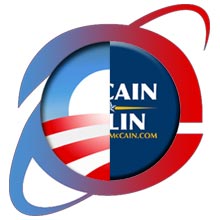The Year in Web Politics
The Web played a huge role in this year’s presidential campaigns. On Election Day, Joe Trippi–a political consultant who deployed an Internet-centric strategy as Howard Dean’s 2004 campaign manager during that year’s elections–had this to say about Barack Obama’s use of Web-based phone banks to get out the vote: “It’s pretty amazing. It’s come a long way in four years.” (See “It’s the Web, Stupid.”) Trippi’s comment could have been about how the Web revolutionized political campaigning in general.

It was clear in 2007 that Obama would make the Web central to his campaign. (See “How Obama Really Did It.”) His Web campaign centered around a social-networking site called my.barackobama.com, which allowed people to organize, call voters, donate, and channel their energies effectively. Beyond that, Obama exploited text messaging, YouTube videos, and other platforms better than did his opponents. (Obama had roughly 3.5 million Facebook supporters, compared with John McCain’s 600,000.)
But while McCain didn’t always make the Web as central to his campaign, some of his supporters now say that it was his skeletal Web operation that sustained him during the leanest stretch in 2007 (see “McCain’s Web Win”), enabling him to win the New Hampshire primary and, ultimately, the Republican nomination.
After Obama won the presidency, he was quick to launch a new transition-team site (see “Change (Dot Gov) Is Here”) that invited people to download their stories from the campaign. Meanwhile, a pair of websites unrelated to Obama’s transition team launched that invited people to propose ideas to the new administration and vote on them. (See “Launching a Wiki Government.”) Later, the Obama transition team launched similar features on change.gov, allowing people to pose questions to the administration and vote on those questions, and also soliciting posted comments that were then addressed by cabinet appointees in YouTube videos. (See “The Extensible Obama.”) Obama has promised to use technology to bring more transparency and accountability to government, and to invite more public participation.
Immediately after the election, Blue State Digital, the Web contractor that supplied the online organizing tools to the Obama campaign, said that the Obama e-mail and volunteer list appeared to be the largest ever amassed in American political history (see “Obama’s Web Future”), implying that Obama might go on to use it as a governing tool. Later, the numbers came out on just how vast Obama’s Web successes had been. Among other remarkable achievements, he’d received $500 million in donations through the Web, and his volunteers had made more than three million phone calls to voters using new Web-based interfaces. (See “Beyond Change.Gov.”)
Thanks partly to Obama’s Web-centric campaign, with distributed armies of supporters interviewing voters before primary elections and the general election, the Democratic National Committee now holds 10 times as much data on voters as it did at the end of the 2004 campaign. Some 223 million new pieces of data on voters were added to the database, including intelligence on who people voted for, how strong their support for Democratic or Republican candidates was, and what issues they most cared about. (See “The Democrats’ New Weapon.”) So while it remains to be seen just how extensively Obama will use the Web to help him govern, it’s pretty clear that the Web will be even more central to political campaigns in 2010 and 2012 than it was in 2008.
Keep Reading
Most Popular
Large language models can do jaw-dropping things. But nobody knows exactly why.
And that's a problem. Figuring it out is one of the biggest scientific puzzles of our time and a crucial step towards controlling more powerful future models.
How scientists traced a mysterious covid case back to six toilets
When wastewater surveillance turns into a hunt for a single infected individual, the ethics get tricky.
The problem with plug-in hybrids? Their drivers.
Plug-in hybrids are often sold as a transition to EVs, but new data from Europe shows we’re still underestimating the emissions they produce.
Stay connected
Get the latest updates from
MIT Technology Review
Discover special offers, top stories, upcoming events, and more.